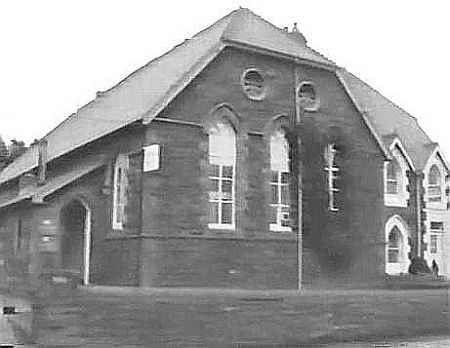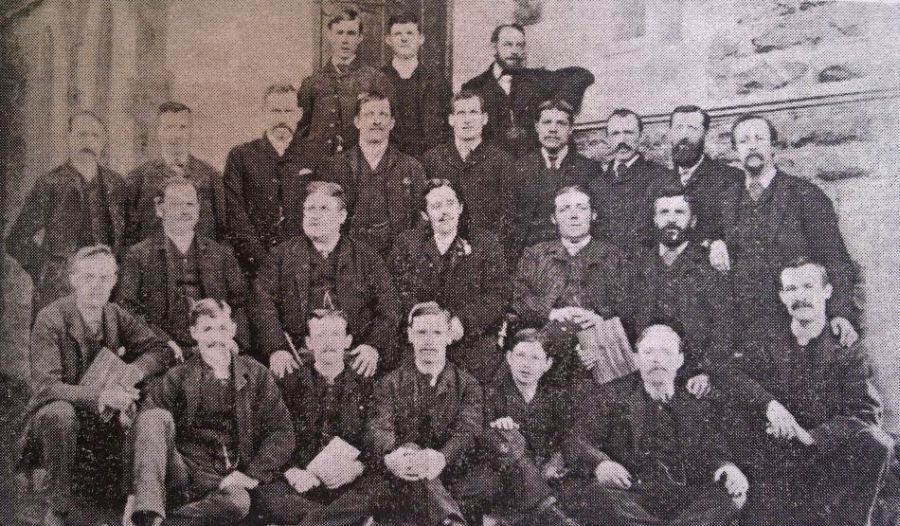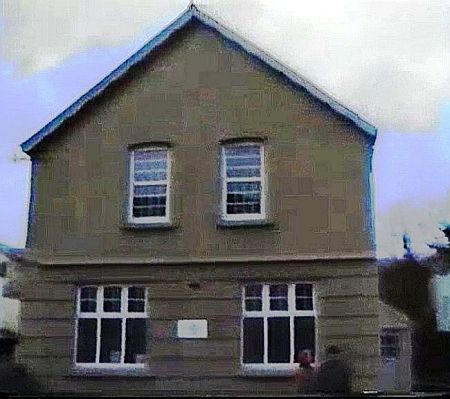Garnant Library Feb 1994
In the 1800's Cwmamman had no purely social venues other
than drinking establishments and the need for such a venue was recognised
by a group of local individuals. After several meetings were held,
it came about that Stepney Hall which was built in the 1880's as a
sunday school for New Bethel Chapel, was rented by the founders of
the Reading Room, who opened the venue to the public in March 1890.

Stepney Hall 1994
The goal of the founders was to provide a cultural centre
where young men could gather together to chat, acquire general knowledge
and play games such as draughts and dominoes. It was also a place
where local people could go to read newspapers, which were scarce
and purchased by very few householders in the village at that time.
A brief history of the institution was written by Joe
Bevan in 1960. Joe had held the position of librarian there for 48
years and had also been secretary for 7 years by the time that his
publication was completed.
Joe wrote that the Reading Room was the meeting place
every evening for the workers after their day's work. They would read
the daily and weekly papers and they met in groups to discuss local
and national issues. They argued hotly at election times, discussed
trade union matters and also held their penny readings there. In Joe's
words, the Reading Room was essentially a "folk cultural institution."
Joe Bevan had in his possession a manuscript sheet written in copper
plate style by the first secretary John Morgan James. On it were the
names of the officers appointed for the year ended March 1891:
President:
Rev.
J. Towyn Jones, Brookland Villa |
Vice Presidents:
Dr Howell Rees, J.P. , CC, Tyrbach
Mr David Morgan, Neuadd Mill
Mr James Rees, Manchester House
Mr Evan M. Williams, Gwalia Villas
Mr Thomas Thomas, Post Office
Mr Rees Davies, Ironmonger
Mr John Thomas, Stepney House |
Officials:
Mr Evan M. Williams, Chairman
Mr
John Morgan Jones, Secretary
Mr David Morgan, Treasurer
Mr Morgan Richards, Assistant Secretary
Mr T. Mitchell, Tutor
John Richards succeeded Professor John Morgan Jones as Secretary
1893-1911 (for 18 years) |
The original committee were made up of a good cross
section of the community, consisting of: 12 tinplate workers, 8 miners,
3 shopkeepers, a carpenter, a miller, a colliery manager, 2 students,
a preacher and a doctor.
| Members of the Committee: |
Evan Davies
Davey Edwards
Rees Jones
John Hendre
Henry Morgan
Lemuel Price
W. J. Thomas
Jacob Jones |
Henry Jones
Thomas Michael
Thomas Morgan
Jacob Rees
Richard Williams
Thomas Davies
H. Jeremiah
Jonathan Jones |
John Morris
Evan Powell
John Richards (2nd Secretary), Springfield Terrace (last to
survive; died 1948)
Thomas Williams
|

Garnant Reading Room Founders circa 1890. Please move the cursor
over the faces to see their names.
Membership of the Reading Room cost a penny a week.
Non members would pay a penny for entry and place the money into a
collection box inside the entrance. The box showed the words "VISITORS
PENCE".
On winter evenings, small competitive concerts were
held at Stepney Hall and these proved very popular, drawing in visitors
and competitors from other villages. The hall would be crowded during
these events and the winners would take home substantial prizes. These
small concerts were commonly known as Penny Readings. The charge for
admission to the penny readings was: threepence for an adult and a
penny for children.
Stepney Hall housed the Reading Room for 47 years, after
which time, the venue was changed to a new place known as "Garnant
Library and Institute" which was once a taylor's shop built by
the owner of Garnant House sometime between 1918 and 1923. In 1938,
the building was purchased by the local Miners' Federation who converted
it into a library downstairs and a billiard hall upstairs.
As the years passed, the villages of Garnant and Glanamman
grew and new entertainment venues opened to the public. A social club,
cinema and a dance hall were avaiable to entertain the people of Cwmamman.
Technology such as Radio and eventually Televisions became well loved
pastimes and more and more people purchased newspapers of their own.
These factors had an impact on the usage of the Reading Room in that
it's importance to the community became diminished.
By 1953, partly due to the closing of local collieries
affecting the income of local families, the Reading Room faced a financial
crisis. Weekly contributions to the establishment had dwindled badly
and it was necessary to lay off both the caretaker and cleaner. Three
old age pensioners volunteered to look after the institution free
of charge in order to stop it closing down One of these was Joe Bevan
who took up the role of caretaker.
However, the Reading Room and Library survived the financial
storm and by 1960, the facility was once again thriving, helped by
its close link to the Carmarthenshire County Circulating Library.
This link was initiated by Librarian Joe Bevan and the result was
that Garnant's Reading Room received valuable financial and material
support. In 1960, there were a progressively increasing number of
book borrowers visiting the Reading Room, most of whom required fictional
works.
It was, however, recognised that the future of the Reading
Room was uncertain as its maintenance costs were much higher than
its regular and assured income and the deficit was made up by donations
and gifts. It was envisaged that at some point in the future it may
become necessary to appeal to the County Council to take over the
institution, which would result in the nature and constitution changing.
It was believed that if the council took over, then the building may
become a community centre..
The construction of a new primary school at Folland Road meant that
a community centre and library space was incorporated into the new
building. Garnant Library, under the control of the county council
relocated from 77 Cwmamman Road to Ysgol y Bedol School in 2005. It
currently opens for only a short time, three days a week.
Information for this page was taken mainly from
"The History of Garnant Reading Room and Library 1890 - 1960"
by Joe Bevan. Thanks to Huw Bevan and family for permission to use
information and images from Joe Bevan's book in the construction of
this webpage.


